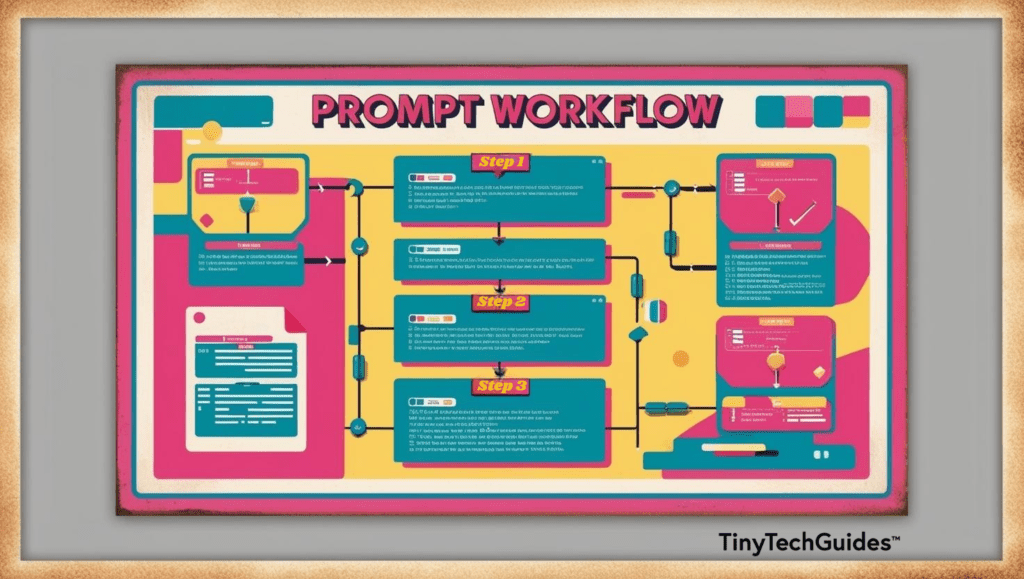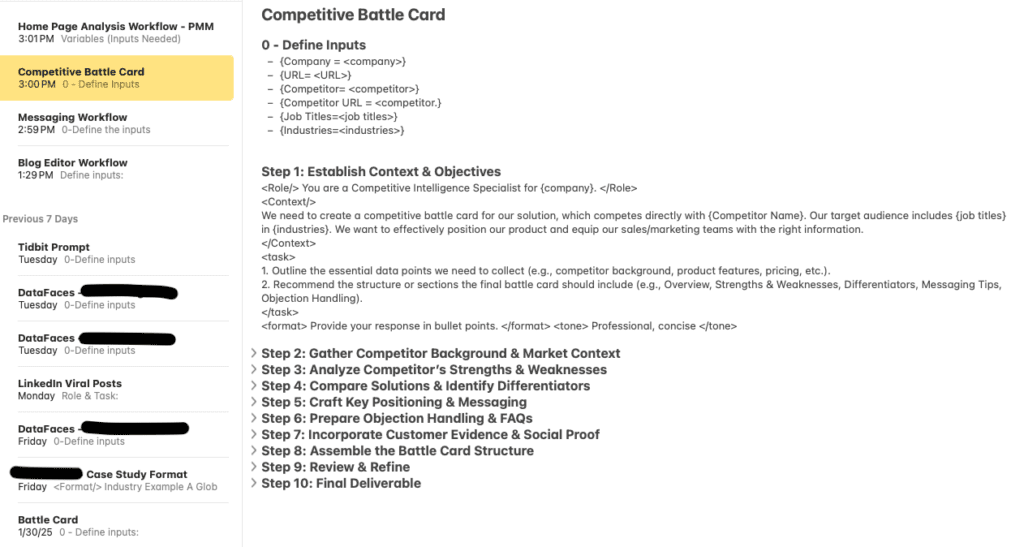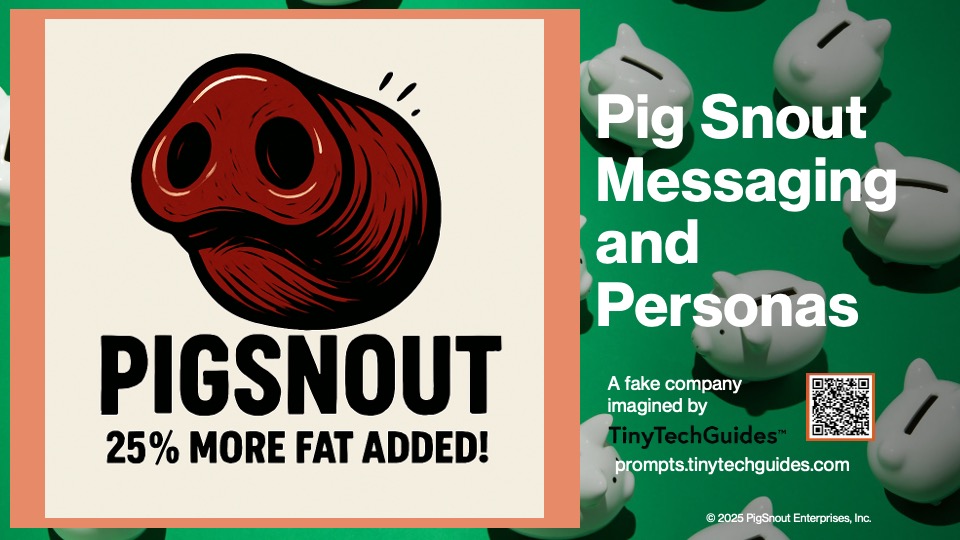Insider Secrets to Building High-Impact Prompt Workflows for Marketing and Sales

Note: This first appeared in prompts.tinytechguides.com, please sign up so you’re the first to know.
Unless you’ve been living under a rock, as a B2B marketing leader, you’re certainly aware that generative AI can accelerate content creation. Your team has likely already invested in the tech, from language models like ChatGPT, Gemini, Claude, and DeepSeek to content generators like Copy.ai. That’s all and well but are you truly maximizing their impact?
The real challenge isn’t access to AI – it’s implementing the operational workflows to use it effectively at scale. It’s not about individual prompts in isolation, but the martech stack and entire ecosystem around them. Prompts, those carefully crafted inputs that shape AI outputs, are the fundamental building blocks. But they need to be embedded into clear processes and workflows to drive repeatable success.
>A prompt workflow is a structured approach to creating, refining, and managing a sequence of prompts used to guide AI content generation. It combines human oversight with AI assistance to streamline content production while ensuring quality and alignment with business objectives.
When used wisely, prompt workflows become force multipliers for go-to-market (GTM) teams. They provide a structured approach to create, refine, and manage sequences of prompts in service of key content objectives.
But crafting high-performing prompt workflows is equal parts art and science. It requires deep audience understanding, subject matter expertise, and a willingness to iterate. Many refer to this as prompt engineering.
https://prompts.tinytechguides.com/p/b2b-prompt-engineering-for-pmms
Based on work with many B2B product marketers, sales enablement pros, and CMOs, this guide shares the battle-tested prompt engineering techniques that deliver impactful results. You’ll learn how to:
- Develop prompt workflows for your most critical content needs
- Implement processes to systematically update, remix, and build assets
- Ensure quality control without sacrificing speed
- Foster a culture of shared learning and workflow optimization
Whether you’re driving product launches, enabling sales teams, or delivering thought leadership content, the following principles will help you maximize the value of every prompt in your workflow.
Prompt Workflows vs. AI Agents: What’s the Difference?
Before we jump into the specifics of prompt workflows, it’s important to clarify how they differ from AI agents.
Essentially, AI agents are autonomous systems that can perform tasks and make decisions based on predefined rules and machine learning (ML) models. They often involve natural language processing (NLP) and generation (NLG), powered by prompts under the hood. However, the key distinction is that AI agents are typically designed to operate independently, with minimal human intervention after initial setup.
Prompt workflows, on the other hand, are human-in-the-loop (HITL) processes. While they use generative AI similar to Agents, they rely on human input, oversight, and iteration between eash step in the process. The “workflow” aspect emphasizes the series of steps and human touchpoints involved in prompt creation, refinement, application, and management.
Where AI agents aim for full automation, prompt workflows recognize the role of human subject matter experts (SMEs) in guiding AI tools to generate high-quality, on-brand content. They provide guardrails and quality control measures to ensure outputs align with strategic objectives.
That said, prompt workflows and AI agents do share common ground in their use of natural language prompts as inputs. And both aim to scale content production and streamline marketing operations. The difference lies in the level of human involvement and the emphasis on the process vs. full automation.
With that context in mind, let’s explore how to design effective prompt workflows for your B2B marketing needs.

Three Essential Workflows
Let’s get tactical. After testing dozens of workflows across a number of different use cases, three workflow patterns stand out as the workhorses for B2B content production. Master these core plays and you’ll be well on your way to prompt engineering success. Please note, these are not the full prompts I would use to make updates, but rather, are illustrative of the three patterns.
1. The Update Engine
Use case: You have existing content that needs a refresh. Maybe it’s updating a battle card with the latest competitive intel or adding new proof points to a case study. The core story remains, but details need to change.
Prompt formula:
"Update this [asset] with the following changes:
- [Change 1]
- [Change 2]
- [Change 3]
Keep the overall narrative and structure intact. Flag any major deviations for review."Pro tips:
- Be specific about what needs to change. The more context you provide, the better the output.
- Explicitly call out elements that should remain untouched to prevent important points from being altered.
- When in doubt, err on the side of more instruction vs. less. It’s easier to pare back than to regenerate.
2. The Content Multiplier
Use case: You’ve invested time and effort into creating a valuable piece of content – maybe a technical white paper or in-depth blog post. Now you want to atomize that core asset into multiple smaller, purpose-built pieces across different formats and channels.
Prompt formula:
"Using [core asset] as the foundation, create the following derivative content pieces:
1. [Format 1] focused on [key points/audience]
2. [Format 2] highlighting [specific angle/data points]
3. [Format 3] adapted for [channel/medium]
Ensure each piece aligns with its specific purpose and target audience."Pro tips:
- Provide clear guidance on what each derivative asset should focus on and who it’s for. The tighter your briefs, the more tailored the outputs.
- Specify desired tone, length, and level of detail for each piece.
- Consider creating a content matrix mapping key messages to different personas and funnel stages.
3. The Greenfield Generator
Use case: You’re starting from a blank slate on a new content asset, whether that’s a customer-facing piece like a solution brief or an internal resource like a sales playbook. You have raw inputs like product info, market research, and SME interviews, but they need to be synthesized into a cohesive narrative.
Prompt formula:
"Develop a [content type] covering the following key points:
- [Topic 1]
- [Topic 2]
- [Topic 3]
Use the following source material as inputs:
- [Source 1]
- [Source 2]
- [Source 3]
Organize the content into a logical flow, weaving in examples and supporting data. Adopt a [tone] voice that resonates with [target audience]."Pro tips:
- Curate your inputs carefully. As they say, garbage in, garbage out. Quality sources lead to quality content.
- Provide as much structure and direction as possible in terms of key points to hit, desired narrative arc, and target tone/audience. The AI can connect the dots, but you need to provide the map.
- Run initial drafts by SMEs to gut check for accuracy and completeness.
Your Personal Prompt Library
Think of prompts like code snippets. Good developers don’t write everything from scratch but rather, they build a library. And more recently, simply as a GPT. The same principle applies here. I’ve tested dozens of storage options. Three stand out for Product Marketing Managers (PMMs):
Real-World Storage Options
- Notes (Mac/iOS): Sometimes simple works best. Built-in, syncs fast, and you’re already using it. No fancy features, but that’s the point. Perfect for solo work when speed matters.
- Microsoft OneNote: The enterprise choice. Already paid for, works across devices, integrates with your stack. Yes, the sync can be slow. But your IT team will thank you.
- Notion: Clear winner for teams. You get version history, easy updates, and search that works. The downside? Another tool to manage. But if your team already uses it, start here.
My suggestion, pick one tool and stick with it. You can use Google Docs, Microsoft Word, Notepad, just about anything. I’ve seen teams lose hours jumping between systems. The best storage system? The one you’ll actually use. Remember, tools change but good organization and the process doesn’t. Start with what you have. Upgrade when it begins to fail.

Quality Control That Matters
Quality checks don’t need to slow you down. After working with marketing teams at a few different tech companies, I’ve found five checks that catch 95% of issues.
The Five-Point Check
- Messaging: Is it on message and on strategy? Does it ladder up to our narrative and reinforce our positioning? Tight messaging maximizes impact.
- Technical details: Did we get the specs right? Are claims backed by data? Tech teams spot mistakes fast. Accuracy builds trust.
- Brand voice: Does this sound like us? Not just tone – the technical depth, market position, and core story. Your brand master will thank you.
- Sales impact: Will this help close deals? Does it have your latest customer stories embedded in the content? Sales teams know what works. If they won’t use it, fix it now.
- Market reality: Does this match what customers see? Good content educates and connects product truth to market needs.
Run these checks in order. Each takes about two minutes. Like reading code – you learn to spot issues quickly. Here’s what I tell my team: “Perfection is the enemy of good. But wrong gets in the way of everything.”
Quick Fixes
When you spot issues, ask:
- Is this a one-time fix or a systematic problem?
- Do we need to update our base templates?
- Should we share this learning with the team?
Build quality into everything you do. As we used to say in my manufacturing days, catch defects early. Think of quality like compound interest – small improvements add up.
Learning Together
What separates good prompts from great ones? The willingness to share and collaboratively refine them. But I know what you might be thinking: “If I share my best prompts, won’t I lose my edge?”
Remember the old adage, a rising tide lifts all boats? When everyone on the team is learning and improving together, the collective knowledge compounds. You tap into the wisdom of crowds and hopefully will develop ideas and inspiration that you wouldn’t have on your own.
I think of it this way, the most innovative companies aren’t the ones with the most secrets. They’re the ones with the most shared knowledge and the fastest iteration cycles. The same principle applies to prompt engineering.
Smart Ways to Share
Keep it simple:
- Quick team lunches where people show what worked.
- A shared space in Notion or OneNote.
- Monthly “what we learned” updates.
- Cross-team testing of new approaches.
Think of it like peer code review, but faster. One marketer’s discovery becomes everyone’s advantage.
What Makes the Difference
Track what matters:
- Which prompts others pick up and use.
- Where teams need to make fixes.
- Unexpected successes.
- Time saved on routine tasks.
Remember, your competitive advantage comes from your unique blend of skills, experiences, and insights. Sharing prompts doesn’t diminish that – it amplifies it by adding to your toolkit. So don’t be afraid to share what you know. The whole team will be better for it.
Conclusion
Here’s what twenty years in tech marketing has taught me: tools change, principles don’t. Start with one content type you create often. Build your prompt workflow library. Share what works. Learn from others. Three questions I ask every marketing team:
- What content eats up most of your time?
- Where do reviews get stuck?
- Which basic tasks could move faster?
Good prompts aren’t about perfection – they’re about consistent output that moves business forward. Remember: AI won’t fix bad process. But good process makes AI work better.



